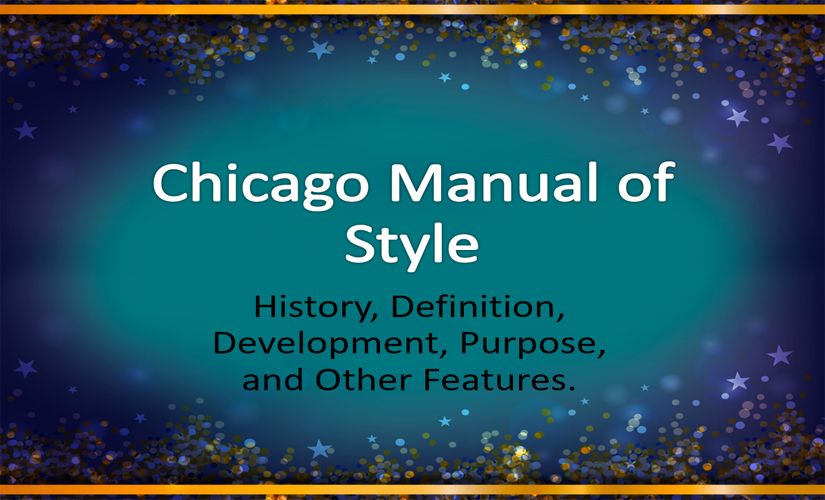The Chicago manual of style traces its history more than one hundred years ago. Basically, the development of the Chicago or Turabian manual of style started in 1891 after the opening of the University of Chicago. In this case, the University found the need to develop a set of rules to process documents. The result was a draft of a style sheet that grew to the current manual. By the early twentieth century, the University of Chicago had a book that contained typological rules. Hence, the Chicago/Turabian rules have expanded to the last edition, which is used by thousands of scholars in history and humanities when making short and long citations to avoid plagiarism.
Definition
The Chicago manual of style is a document that covers a variety of topics for different types of papers. Some essay topics help scholars to edit their work in the Chicago style. For instance, the manual contains information on manuscript preparation and publication, grammar usage, and documentation. Moreover, the Chicago format or Turabian citation rules describe two documentation formats to suit the needs of various subjects compared to other paper formats. The first system is the note-bibliography format, which is common in literature, history, and arts. In this case, the note-bibliography style requires scholars to use footnotes for Chicago style citation. Then, the second approach is the author-date system, which is common in the social sciences. In this system, scholars use parenthetical in-text citations. Therefore, the Chicago manual of style contains rules that guide scholars in various areas of study to edit their works.

The Development of the Chicago Manual of Style
The development of the Chicago manual of style started in 1891 to the current seventeenth edition. The first publication of the Chicago style citation manual of fashion took place in 1906. Basically, the first edition was approximately 200 pages and entailed typological rules that guided writing at the University of Chicago Press. The scholars at the University of Chicago played a significant role in upgrading the regulations in the Manual of Style. An excellent example is Kate Turabian while she is an author of the Turabian format. In particular, she developed the Manual of Style as a condensed version to present accurate and precise rules for students. Hence, these efforts have enabled students in history and humanities from different institutions to use the Chicago/Turabian rules to cite information in their academic work. Thus, the development of the Chicago/Turabian format began in the late nineteenth century.
The Purpose of Chicago/Turabian Rules
The purpose of the Chicago manual of style is to cite scholarly work and avoid plagiarism. For example, proper citation in the Chicago/Turabian style ensured that history students give credit to scholars who compiled, analyzed, and distributed their research. Along these lines, the Chicago/Turabian guide helps students to show that they consult experts in and present findings properly. Besides, proper citation of sources allows readers to assess the scholarly sources and judge how well students use them in their writing.
Teaching and Learning
The Chicago manual of style also helps teachers to evaluate the understanding abilities of learners. In this case, readers assess whether students include important information by historians who specialize in the topic in question. As a result, the ultimate purpose of the Chicago/Turabian rules is to help make critical interpretations of history. Citations enable other scholars to review the sources used and determine if they arrive in similar conclusions. Scholars revised and improved on outcomes that mislead, which resulted in new interpretations. Therefore, the Chicago format allows scholars to make proper citations to avoid plagiarism.
Historical Evidence on Chicago Manual of Style
The Chicago manual of style has undergone significant developments from 1906 to 2017. The most useful version of the Manual of Style began in the 1960s led by Catherine Seybold. The purpose was to rearrange, expand, and update the eleventh edition. Also, the new version gained popularity across scholars. In turn, the sixteenth and seventeenth editions focus on new digital technologies and contain guidelines on how to cite websites among other electronic sources. Hence, the new edition provides best practices that help scholars to prepare electronic manuscripts adequately. Therefore, the Chicago manual of style has undergone significant changes to include ways to cite and develop digital sources.
Statistics
The Chicago manual of style has hundreds of thousands of users across the world. For example, the fourteenth edition Manual of Style reached over one million sales in 1993. Basically, the numbers show that various institutions encouraged the use of the Chicago style format. Moreover, the growth of Internet technologies increased the number of users of the Manual of Style. For instance, the Chicago/Turabian format online received over two hundred recurring visitors in 2010. In this case, these numbers show again in popularity in the use of the Manual of Style. Therefore, the Chicago style has gained many users across the world.
Conclusion on Chicago Manual of Style
In conclusion, the development of the Chicago manual of style began in the late twentieth century. With time, scholars revised the first pamphlet to create an extensive and useful manual for others. In this case, the Manual of Style is significant for students of history and humanities. The rule in the Manual of Style helps scholars to deliver original work when they cite Chicago. Currently, several hundreds of thousands of scholars use the last version of the manual.

